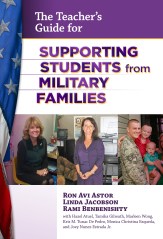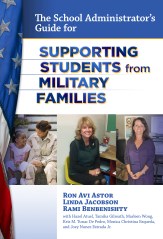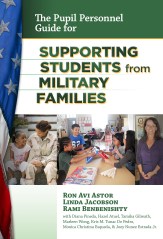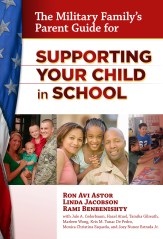The divide between U.S. society and the American military reveals itself in strange places – children’s classrooms, for example. More than 1 million military kids face unusual challenges: they haven’t been in a specific school long enough to play sports, for example, or their constant moves – many attend nine different schools before college – cause them to lag behind their classmates. That’s why the American Association of Colleges of Teacher Education, the Military Child Educational Coalition and Joining Forces, a campaign to help veterans and their families started by First Lady Michele Obama and Jill Biden, have partnered to create Operation Educate the Educators.
The group has signed up more than 100 university schools of education to include materials about military families in their teacher training and internship programs. The books have just been published by a partnership of the University of Southern California and eight southern California, military-heavy school districts. They give teachers, principals, school social workers and other staff members background on military children, as well as practical, easy-to-implement programs that have a proven track record. Battleland spoke with three of the key authors in an email interview earlier this week:
You have written four different books about military students. Why?
Ron Avi Astor: Millions of warriors, their spouses, and children have endured great sacrifice during the wars of the past decade. For the families, this includes many moves and transitions.

Steve Cohn
Military children attend an average of nine schools. It also includes dealing with multiple deployments, separation, personal losses, and reintegration. Millions more families will be transitioning back into civilian society in the next few years.
Unfortunately, if you walked through our major cities and most public schools or universities, you may not know our country has been at war for more than a decade.
This is sometimes even true on national holidays like Veterans Day. Schools might have a day off, but in far too many schools there is no education or recognition of students or families that served or are currently serving.
This is why Michelle Obama and Dr. Jill Biden initiated the Joining Forces effort. This campaign is a national attempt to engage all sectors of civilian society to support military families. Civilian culture and public schools across the country have not uniformly shown the kind of support for military families and veterans in these wars like they did in WWII or other past war efforts.
Through research and experience, we know that civilian communities, schools, and society can play a large role in supporting and reintegrating military families by showing acknowledgment of military culture, acceptance, employment, high-quality social services, and by genuinely honoring the sacrifices entire families made during to the long wars.
 In part, many public schools don’t often see military families as culture because few universities educate teachers, administrators, counselors, or other professionals that military families have a distinct, proud, and resilient culture.
In part, many public schools don’t often see military families as culture because few universities educate teachers, administrators, counselors, or other professionals that military families have a distinct, proud, and resilient culture.
Few colleges teach educators how to structure their classes, schools, or school districts to support military families. This military cultural awareness is essential, because over a million military children attend public, civilian-run schools.
A large number of National Guard and Reserve families often live far away from bases and don’t have the same support that the other branches of the military have. If you include children of recent veterans, the numbers are much higher. Only a small fraction of military students attend DoD schools.
Civilian educators not near a base may not be aware that they have military children in their classrooms or that they come from a distinct resilient culture with a proud tradition, values and rituals. This is also why the White House recently launched the Educating the Educators campaign.
In partnership with the American Association of Colleges of Teacher Education (AACTE) and the Military Child Education Coalition (MCEC), the White House has signed up over 100 university schools of education that have agreed to include materials, placements and programs that address the needs of military children in schools.
I was at that meeting several years ago when the idea was hatched with Dr. Jill Biden’s and Michelle Obama’s staff. We committed our university and consortium efforts to finding the very best, vetted information for those university training programs and school districts so that the vision behind Educating the Educators could come to fruition.
These guides are part of a focused, national effort to provide a compilation of best practices for civilian public schools and universities so that they create military-friendly environments. For that to work, the information provided needs to be very specific to each profession. Each book addresses the needs and supports from the vantage point of that professional’s role or from that of a parent. Overall the four books address the civilian-military divide in our culture.
USC created a masters level program that trains social work professionals how to work in military-connected public schools. We also work in partnership with San Diego State University and U.C. San Diego.
In the past few years, these undergraduate and graduate university interns have provided close to 60,000 internship hours in San Diego regional public schools. Because we have many partners and boots on the ground we are able to evaluate and compile the best ideas, practices, and evidence-based programs from the dedicated professionals working in these schools.
The military school liaison officers have been instrumental in generating cutting edge programs we’ve highlight. We were able to work with partners to capture videos of model schools and practices. The videos are free companions to the guides on the website. These are practices that any university can teach and any school can implement to support the families with very little or no funding.
To provide the right supports, school professionals and parents need different information relevant to their role. That’s why it’s critical to have separate books for teachers, administrators, pupil personnel and parents. It truly does take a village to educate a child.
By the way, all royalties from the four books are donated to military-child education causes.
Tell us a little about each book.
Linda Jacobson: The teacher book focuses on instructional practices as well as the social-emotional climate a teacher can create in the classroom to support military students. Teachers need to know how to welcome new military kids into the existing peer group.

TCP
By the time they are in high school, a military child may have attended as many as nine schools. One of the important goals is not to single out, embarrass, or stigmatize individual children. We have seen classroom-wide and school-wide programs that help all the students in that classroom and school, not only military kids.
Any new student might need some quick tutoring on a topic or skill they missed in the process of changing schools. They may need someone from their class to sit with them at lunch for a few days or show them around the school. A teacher could help by informally introducing new parents to the room parents or connecting them to the PTA. A teacher needs to know how to emotionally support both the parents and students so that the transition into a new school goes smoothly.
The curriculum can also be adjusted to show sensitivity to a child whose parent is about to be deployed or is currently in harm’s way. The book suggests that teachers integrate information about the current war with the study of past wars in our nation’s history. Creating a hero board, geographical maps showing where families have lived around the world, and allowing space and time for students to talk about their family backgrounds help students get to know new students.
The book also encourages teachers to work with their colleagues and student support personnel to monitor any ongoing learning or social issues students from military families might be having in the classroom or with other students.
 The administrator book: The administrator’s purview is the entire school or district. A principal or superintendent can set the tone for the entire school staff on the importance of welcoming and supporting military families.
The administrator book: The administrator’s purview is the entire school or district. A principal or superintendent can set the tone for the entire school staff on the importance of welcoming and supporting military families.
They can provide professional development on working with military families and kids. They can help set policy so that each transitioning military child is linked up immediately with tutoring, extra-curricular programs and other services both at school and in the community. They can seek and direct resources, fundraising and grants to support military families and students.
They can also direct funding toward having enough school counselors and can form partnerships with community agencies so students receive the mental health, mentoring or tutoring services they need. A principal can partner with a university or community college to make tutoring services available for students. UCSD has a program called Partners at Learning that we highlight in one of our videos.
Some principals also recognize military children and families through celebrations or cultural rituals. One school held a Marines’ birthday celebration, which demonstrated the history and a cake-cutting ceremony to educate the civilian students. This sent a strong signal to military and veteran families that their experiences and service were valued at the school.
The principal of the school talked about how the event set a good example for all of the students and provided an opportunity to encourage students to pursue excellence both in and out of school. Another school held a military appreciation assembly and gave active duty and veteran parents a chance to talk about their service to their country.
The administrator book also provides examples of working with parents, military leaders and community organizations to create a positive school climate.
 The pupil personnel book: School counselors, social workers, nurses or psychologists focus on removing the obstacles that stand in the way of a child being successful academically or having a smooth transition into a new school. These can include family stress related to a parent’s deployment, gaps in learning, behavior problems, or a need for mental health services.
The pupil personnel book: School counselors, social workers, nurses or psychologists focus on removing the obstacles that stand in the way of a child being successful academically or having a smooth transition into a new school. These can include family stress related to a parent’s deployment, gaps in learning, behavior problems, or a need for mental health services.
There may also be children who are experiencing trauma related to a military parent’s physical disability, reintegration after war, or even death. Some families face financial difficulties when a spouse is deployed. Children with an older sibling in the military may also be worrying about his or her safety. Research shows that a good number of military children are bullied because they are new in their schools.
But there are programs, such as FOCUS — Families OverComing Under Stress — created by experts at UCLA, that can help students, teachers and parents learn coping and communication skills through such difficult times. School social workers and others can also help coordinate community resources, write grants, provide services and social opportunities for parents and work with service providers at regional or district levels.
Universities can use the book to train young professionals to work in schools with military families and students. USC, SDSU, UCSD, Old Dominion University, the University of Maryland and others are already demonstrating how this can be done by developing internships and curriculum.
The parent book: Parents are the most important people in a child’s life. How the parents prepare for a transition and navigate the relationships with teachers, the principal, and the new community can impact how a child fares in the midst of a move as well as on a continuing basis.
 In this book, we encourage parents to find out as much as they can about the school their child will attend and to make connections with teachers and other school staff as early as possible. We also have examples of how military parents have taken the initiative to create schools that are more welcoming to military families.
In this book, we encourage parents to find out as much as they can about the school their child will attend and to make connections with teachers and other school staff as early as possible. We also have examples of how military parents have taken the initiative to create schools that are more welcoming to military families.
PTA members have worked with school liaison officers and principals to organize “transition rooms” where new parents and students can get their questions answered, meet other parents and students and find out about school and community programs. These rooms have resources, computers with Skype for contacting deployed parents and activities for young children. In one instance, a mother contracted a serious illness while the father was on deployment. The school community, led by the parents’ organization helped drive the children, delivered meals, helped with homework and made sure the mother got to her doctor’s visits.
Parents at another school created a garden where military students and parents can work and interact with civilian parent volunteers and students. Other schools have organized parent teas or coffee breaks to help new parents feel less isolated.
Parents of older students also need information on how to negotiate with school districts and administrators when their child arrives at a new school without enough credits for graduation, or if units earned in one state don’t count in another state.
The book highlights the provisions of the Interstate Compact on Educational Opportunity for Military Students, which can remove many of these barriers—including requirements related to playing sports or participating in other activities—and can make a difference in whether or not a student graduates on time. The book provides tips and lists of resources for parents.
We have also learned that most civilians want to help if given opportunities to contribute. But it is clear that military parents need to plan, be diligent and be aware of the resources available to their children.
Should military parents be concerned about their children’s education?
Rami Benbenishty: Every parent should be vigilant and involved in their child’s education and military parents are not an exception.

TCP
The good news is that there are many examples of great ways in which public schools are providing amazing educational experiences to military children. We were impressed by the care, love, and devotion show by district educators, School Liaison Officers, military family support services and community organizations.
If a military child is attending one of these amazing schools, military parents can be sure that the school is their ally in facing the challenges of being a military parent. Furthermore, these parents may find opportunities to share and contribute to the school many assets that military families have.
We know, however, that not all the public schools across the USA are doing well. So in that sense, all parents should be vigilant, inquisitive, and involved in their children education. They should be joining forces with educators to create the best school environment for their children.
We have seen multiple examples of military parents whose presence and involvement enriched everyone in their school. Research shows that military kids and families are strong and resilient, and have much to offer to public schools.
Still, the wars of the past 11 years have taken a toll on many of the families and children. Military families need to plan more and encourage their schools to provide the kinds of supports that the model public schools do.
Our research shows that if a school can provide a warm, caring, and welcoming environment to new students, many of the negative outcomes associated with deployment and moves are diminished greatly or even prevented. With the right types of transition supports and cultural friendly environment military students do as well as nonmilitary students even with the multiple deployments and moves.
What’s the most important thing for me, as a military parent, to know about how the education of my children differs from those from non-military families?
Rami Benbenishty: I come from Israel, where the vast majority of Jewish families would be considered military families. Normally both the mother and father serve in the military. I was an officer in the Israeli Defense Forces, and in the reserves almost my entire adult life. I’ve been to war multiple times and so have my children.
Virtually all my children’s teachers, principals, and support staff also served in the military at one point. So in Israel there is almost no awareness gap or cultural divide between the military and nonmilitary families.
However, when I come to the USA, I see different cultural phenomena than the one I see in Israel. Perhaps because in the USA there is an all-volunteer fighting force, the civilian population appears far less invested. Many civilians are not aware that military families are carrying the heavy burden of the war.
I am fully convinced, however, that educators in the U.S. do care deeply for all the children in their schools. What is needed is a major sustained campaign to raise awareness within professionals so that all schools are supportive of diverse cultures, including military children.
As a military parent, I would need to ensure that the school staff respects my child, is aware of our cultural lifestyle or values, understands the stresses associated with having a parent deployed or the need to move so often, provides resources and opportunities to my child, and welcomes my involvement. If a school offers these supports, they can be sure that I will give back to the school so much more.
I therefore feel that these guides are an important tool to help bridge the gap between civilian public schools and military children and families. I am especially enthusiastic about the ways we can collaborate and learn from each other, despite our very different circumstances.
Since few U.S. teachers have served, they also need to be educated on how it feels emotionally when a loved one is off at war. On days when child’s thoughts are occupied by worries and fears of injury, they may not be able to concentrate on mathematics or reading lessons.
Showing care, support, flexibility are something the staff in DoD schools most likely naturally do. The guides can help sensitize civilian educators so that they can be more supportive.
Most of our programs and practices highlighted are implemented school wide and impact both civilian and military students. For example, a good tutoring program that helps every new child that enters the school benefits everyone. Military kids who may have temporarily feel behind due to many moves may also benefit from that program. It could be stigmatic if programs only focused on military students and not others with the same needs.
That’s not what the best schools do. They implement school wide policies that help military families but also all civilian families with similar stress or circumstances.
Does teaching military kids differ from teaching civilian kids?
Ron Avi Astor: No, it’s pretty much the same.
Like any child, a teacher must be knowledgeable about the child’s background, culture, life circumstances, family values, and strengths. That’s good education. That’s all we are asking for with military kids.
The problem is that many public schools don’t know that they have military students, and they don’t reflect the families’ military culture and background in the schools diversity practices.
If educators can learn best practices from each other, and know that they have military kids in their classes, they can better support them academically and socially — so they can continue to thrive.


